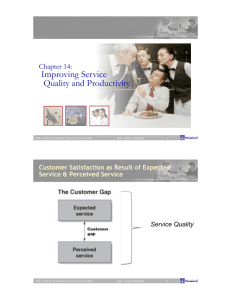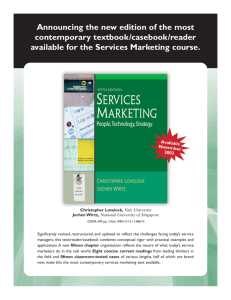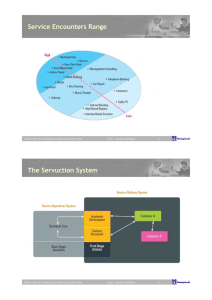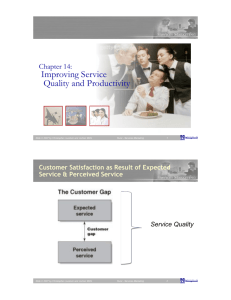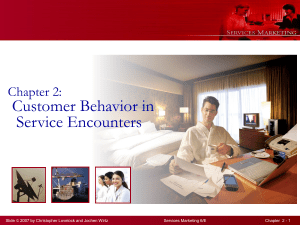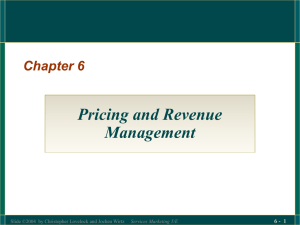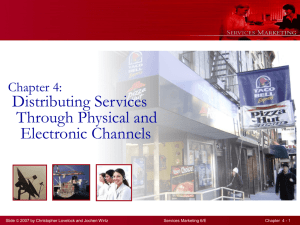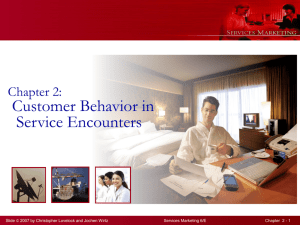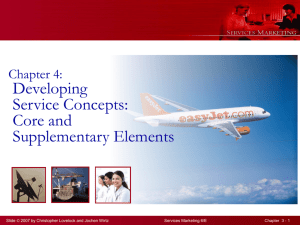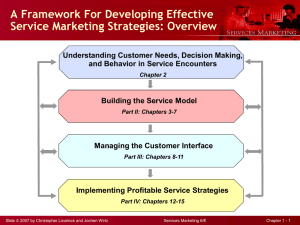Chapter 4
advertisement
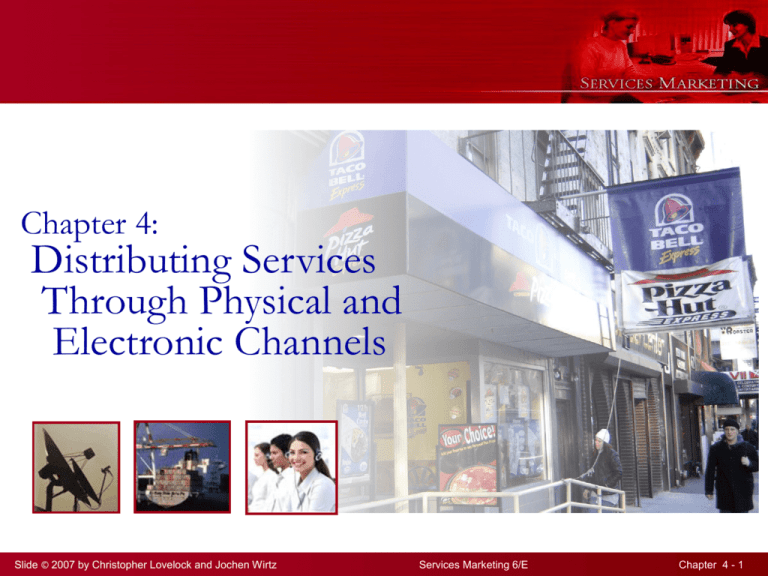
Chapter 4: Distributing Services Through Physical and Electronic Channels Slide © 2007 by Christopher Lovelock and Jochen Wirtz Services Marketing 6/E Chapter 4 - 1 Overview of Chapter 4 Distribution in a Services Context Determining Type of Contact: Options for Service Delivery Place and Time Decisions Delivering Services in Cyberspace The Role of Intermediaries The Challenge of Distribution in Large Domestic Markets Distributing Services Internationally Slide © 2007 by Christopher Lovelock and Jochen Wirtz Services Marketing 6/E Chapter 4 - 2 Applying the Flow Model of Distribution to Services Distribution embraces three interrelated elements: Information and promotion flow To get customer interested in buying the service Negotiation flow To sell the right to use a service Product flow To develop a network of local sites Slide © 2007 by Christopher Lovelock and Jochen Wirtz Services Marketing 6/E Chapter 4 - 3 Distinguishing between Distribution of Supplementary and Core Services Distribution relates to both core services and supplementary services Core services for people processing and possession processing services require physical locations Core services for mental stimulus processing and information processing can be distributed electronically Supplementary services can be tangible or intangible in nature; latter can be distributed widely and costeffectively via nonphysical channels Telephone Internet Slide © 2007 by Christopher Lovelock and Jochen Wirtz Services Marketing 6/E Chapter 4 - 4 Information and Physical Processes of Augmented Service Product (Fig 4.1) Information processes Payment Billing Information Consultation Ordertaking Core Exceptions Hospitality Safekeeping Physical processes Slide © 2007 by Christopher Lovelock and Jochen Wirtz Services Marketing 6/E Chapter 4 - 5 Using Websites for Service Delivery Information Read brochure/FAQ; get schedules/ directions; check prices Consultation Payment Conduct e-mail dialog Use expert systems Pay by bank card Direct debit Billing Order-taking Receive bill Make auction bid Check account status Core Make/confirm reservations Submit applications Order goods, check status Exceptions Hospitality Make special requests Resolve problems Record preferences Safekeeping Track package movements Check repair status Core: Use Web to deliver information-based core services Slide © 2007 by Christopher Lovelock and Jochen Wirtz Services Marketing 6/E Chapter 4 - 6 Distribution Options for Serving Customers Customers visit service site Convenience of service factory locations and operational schedules important when customer has to be physically present Service providers go to customers Unavoidable when object of service is immovable More expensive and time-consuming for service provider Service transaction is conducted remotely Achieved with help of logistics and telecommunications Slide © 2007 by Christopher Lovelock and Jochen Wirtz Services Marketing 6/E Chapter 4 - 7 Six Options for Service Delivery (Table 4.1) Availability of Service Outlets Type of Interaction between Customer and Service Organization Customer goes to service organization Service organization comes to customer Customer and service organization transact remotely (mail or electronic communications) Slide © 2007 by Christopher Lovelock and Jochen Wirtz Single Site Multiple Sites Theater Bus service Barbershop Fast-food chain House painting Mail delivery Mobile car wash Credit card company Broadcast network Local TV station Telephone company Services Marketing 6/E Chapter 4 - 8 Channel Preferences Vary among Customers For complex and high-perceived risk services, people tend to rely on personal channels Individuals with greater confidence and knowledge about a service/channel tend to use impersonal and selfservice channels Customers with social motives tend to use personal channels Convenience is a key driver of channel choice Slide © 2007 by Christopher Lovelock and Jochen Wirtz Services Marketing 6/E Chapter 4 - 9 Places of Service Delivery Cost, productivity, and access to labor are key determinants to locating a service facility Locational constraints Operational requirements - Airports Geographic factors - Ski resorts Need for economies of scale - Hospitals Slide © 2007 by Christopher Lovelock and Jochen Wirtz Services Marketing 6/E Chapter 4 - 10 Places of Service Delivery Ministores Creating many small service factories to maximize geographic coverage - Automated kiosks Separating front and back stages of operation - Taco Bell Locating in multipurpose facilities Proximity to where customers live or work - Service stations - Service Perspectives 4.2 Slide © 2007 by Christopher Lovelock and Jochen Wirtz Services Marketing 6/E Chapter 4 - 11 Time of Service Delivery Traditionally, schedules were restricted Service availability limited to daytime, 40 to 50 hours a week Sunday historically considered as a rest day in Christian tradition, Saturday in Jewish tradition, and Friday in Muslim tradition Today For flexible, responsive service operations: - 24/7 service—24 hours a day, 7 days a week, around the world (Service Perspectives 4.3) Some organizations still avoid 7-day operations, for example: - Atlanta-based Chick-fil-A “Being closed on Sunday is part of our value proposition” Slide © 2007 by Christopher Lovelock and Jochen Wirtz Services Marketing 6/E Chapter 4 - 12 Service Delivery Innovations Facilitated by Technology Technological Innovations Development of “smart” mobile telephones and PDAs as well as Wi-Fi high-speed Internet technology that links users to Internet from almost anywhere Voice-recognition technology Websites Smart cards - Store detailed information about customer - Act as electronic purse containing digital money Increase accessibility of services Deliver right information or interaction at right time Create and maintain up-to-date real-time information Slide © 2007 by Christopher Lovelock and Jochen Wirtz Services Marketing 6/E Chapter 4 - 13 e-Commerce: Move to Cyberspace (1) Internet facilitates 5 categories of “flow” Information Negotiation Service Transactions Promotion Electronic channels offer complement/alternative to traditional physical channels Convenience (24-hour availability, save time, effort) Ease of obtaining information online and searching for desired items Better prices than in many bricks-and-mortar stores Broad selection Slide © 2007 by Christopher Lovelock and Jochen Wirtz Services Marketing 6/E Chapter 4 - 14 e-Commerce: Move to Cyberspace (2) Recent Developments link Websites, customer management (CRM) systems, and mobile telephony Integrating mobile devices into the service delivery infrastructure can be used as means to: Access services Alert customers to opportunities/problems Update information in real time See “Online versus Bricks-and-Mortar” (SP 4.4) Slide © 2007 by Christopher Lovelock and Jochen Wirtz Services Marketing 6/E Chapter 4 - 15 Splitting Responsibilities For Supplementary Service Elements As created by originating firm Core (Fig 4.3) As enhanced by distributor + Core product As experienced by customer = Supplementary services Core Total experience and benefits Challenges for original supplier Act as guardian of overall process Ensure that each element offered by intermediaries fits overall service concept Slide © 2007 by Christopher Lovelock and Jochen Wirtz Services Marketing 6/E Chapter 4 - 16 Franchising (1) Popular way to expand delivery of effective service concept Franchising is a fast growth strategy, when Resources are limited Long-term commitment of store managers is crucial Local knowledge is important Fast growth is necessary to preempt competition Study shows significant attrition rate among franchisors in the early years of a new franchise system One-third of all systems fail within first 4 years Three-fourths of all franchisors cease to exist after 12 years Slide © 2007 by Christopher Lovelock and Jochen Wirtz Services Marketing 6/E Chapter 4 - 17 Franchising (2) Disadvantages of franchising Some loss of control over delivery system and, thereby, over how customers experience actual service Effective quality control is important yet difficult Conflict between franchisees may arise especially as they gain experience Alternative: license another supplier to act on the original supplier’s behalf to deliver core product, for example: Trucking companies Banks selling insurance products Slide © 2007 by Christopher Lovelock and Jochen Wirtz Services Marketing 6/E Chapter 4 - 18 Dunkin’ Brands Distributes Its Branded Service Concepts through Franchisees (Fig 4.4) Dunkin’ brands: Dunkin’ Donuts (coffee and backed goods), Baskin Robbins (ice cream), Togo’s (sandwiches) Slide © 2007 by Christopher Lovelock and Jochen Wirtz Services Marketing 6/E Chapter 4 - 19 The Challenge of Distribution In Large Domestic Markets Marketing services (i.e., physical logistics) face challenges due to: Distances involved (geographic areas) Existence of multiple time zones Multiculturalism (especially, immigrants and indigenous people) Differences in laws and tax rates Large U.S. companies counter this by: Targeting specific market segments Seeking out narrow market niches Serving multiple segments across a huge geographic area is biggest marketing challenge Slide © 2007 by Christopher Lovelock and Jochen Wirtz Services Marketing 6/E Chapter 4 - 20 How Service Processes Affect International Market Entry (1) People processing services require direct contact with customers Export service concept - Acting alone or in partnership with local suppliers - For example, e.g., chain restaurants, hotels, car rental firms Import customers - Inviting customers from overseas to firm’s home country - For example, hospitals catering to “medical tourism” Transport customers to new locations - Passenger transportation (air, sea, rail, road) Slide © 2007 by Christopher Lovelock and Jochen Wirtz Services Marketing 6/E Chapter 4 - 21 How Service Processes Affect International Market Entry (2) Possession processing involves services to customer’s physical possessions - For example, repair and maintenance, freight transport Information-based services include mental processing services and information processing services Export the service to a local service factory - Hollywood film shown around the world Import customers Export the information via telecommunications and transform it locally - Data can be downloaded via CDs or DVDs Slide © 2007 by Christopher Lovelock and Jochen Wirtz Services Marketing 6/E Chapter 4 - 22 Factors Favoring Adoption of Transnational Strategies Competition drivers Competitors from overseas; interdependence of countries Firms may be obliged to follow competitors into new markets to protect own positions elsewhere Technology drivers Advances in information technology—miniaturization/mobility of equipment, digitization of voice Cost drivers Economies of scale Lower operating costs Government drivers Favorable trade policies, compatible technical standards, common marketing regulations Slide © 2007 by Christopher Lovelock and Jochen Wirtz Services Marketing 6/E Chapter 4 - 23 Modes of Internationalization Export information-based services Transmit via electronic channels Store in physical media, ship as merchandise Use third parties to market/deliver service concept Licensing agents Brokers Franchising Alliance partners Minority joint ventures Control service enterprise abroad Direct investment in new business Buyout of existing business Slide © 2007 by Christopher Lovelock and Jochen Wirtz Services Marketing 6/E Chapter 4 - 24
